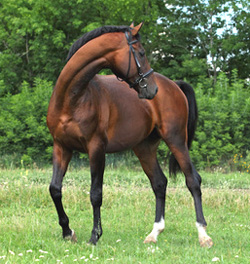If the racehorse has survived a racing
career....
To train a racehorse is a complicated
process. Horses cannot experience a
sudden change of diet and exercise without risk of potentially lethal
colic. Therefore, Thoroughbreds destined
for retirement and a new life outside of the racetrack need their diets and
exercise levels gradually tapered off before they can go into retraining.
Thoroughbreds live an average of 30 years
but usually are retired from flat racing when they are just five and from jumps
racing when they are teenagers. Only
champion mares and stallions head for a new life in the breeding shed. But the majority of racehorses are geldings
or neutered males. Although they cannot
breed, their calmer temperaments make them excellent candidates for retraining
for pleasure riding or driving in harness.
Challenges
Ahead
It is a popular misconception that all
racehorses are retired due to untreatable injuries. Although injuries may occur to prompt a
racehorse trainer’s decision to retire a horse, not all retired racehorses are
lame or sick. Some are retired just
because the horses are too slow for competitive racing. Some have treatable illnesses. Within a year, they can be sound and ready
for their new careers.
It is also a popular misconception thatThoroughbreds are crazy. The high-energy
diets that racers need leads to high-energy horses. This is why a retired Thoroughbred needs to
gradually have his grain rations reduced so he is not so full of excess
energy. Thoroughbreds are intelligent
creatures that are curious about their surroundings and love food. They are willing to learn new things if given
a small food reward like a chunk of carrot.
What
Retired Racehorses Can Do
Racehorses need to unlearn some habits that
the track taught them. Training a racehorse
to be a calm pleasure mount means training the horse as if he never has been
ridden before. Many racehorses equate
the weight of a rider with running as fast as possible. But gradually the horse will learn to wait
for a rider’s cues before walking, trotting or running.
Once a retired racehorse learns the basics
of responding to bridle commands on a lunge line and walking under a rider
without breaking out into a gallop, then he is ready for just about anything
his new career demands. Ex-racehorses can
be found doing tricks for the movies, carrying police officers for crowd
control and given riding lessons to the physically and mentally
challenged. But the majority will go on
to be pleasure mounts and compete in sporting events like hunting and dressage.
Conclusion
The end of a racing career does not mean
the end of a racehorse’s life. Retired
racehorses are suitable for a wide variety of future careers. Training a racehorse for a new life is first
started by a racehorse trainer and then to trainers and volunteers in horse
rescue organizations. There are many
sound and sensible ex-racehorses ready for adoption.
Recommended
Reading
- · Beyond the Track: Retraining the Thoroughbred from Racehorse to Riding Horse. Anna Ford and Amber Heintzberger. Trafalger Square Books; 2008.
- · HorseChannel. “Starting with Off-the-Track Thoroughbreds.” Cindy Hale. September 2007.
- · Steuart Pitman. “Retraining Thoroughbreds for Dressage.” Dressage Today. January, 2013.


No comments:
Post a Comment